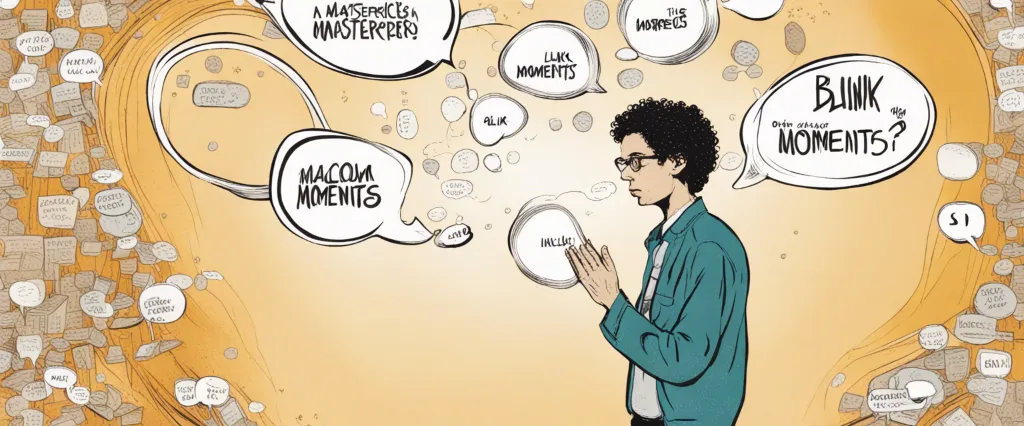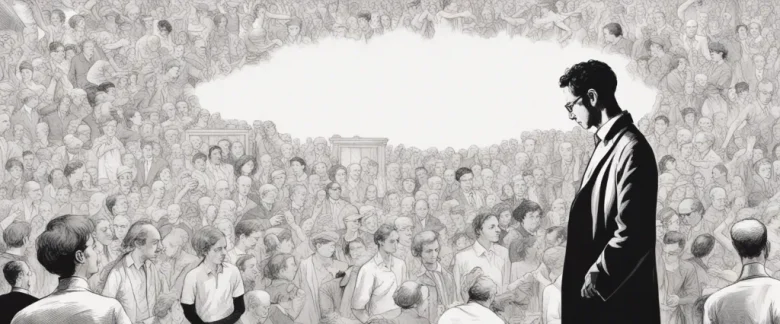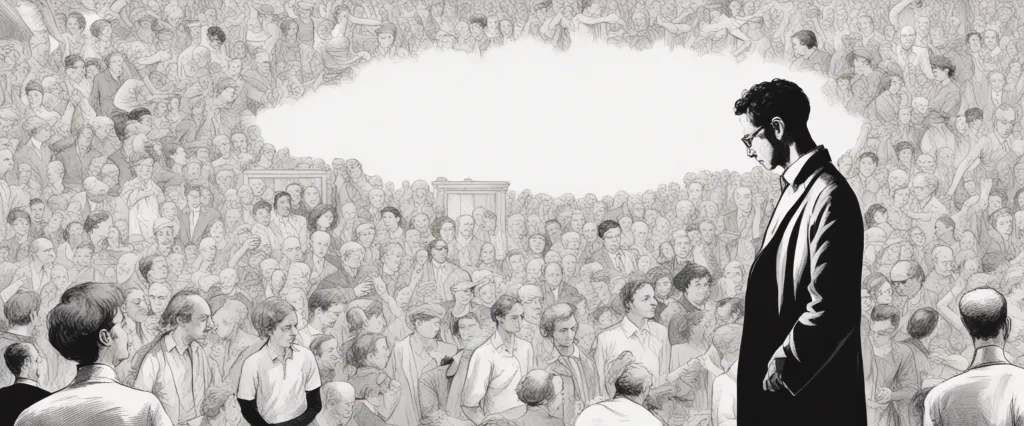In his remarkable book “Blink,” Malcolm Gladwell explores the fascinating concept of rapid cognition and the amazing power of snap judgments. Through vivid storytelling and extensive research, Gladwell delves deep into the human mind’s ability to make split-second decisions, emphasizing that sometimes our gut instinct can be more accurate and insightful than prolonged analyses. As one of the most influential journalists and non-fiction writers of our time, Gladwell has an extraordinary ability to blend captivating anecdotes, psychological insights, and thought-provoking theories to unveil the enigmatic realm of our unconscious thoughts.
Chapter 1: The Power of Intuition
Chapter 1 of “Blink” by Malcolm Gladwell, titled “The Power of Intuition,” explores the concept of thin-slicing and the incredible ability of the unconscious mind to make split-second judgments and decisions. Gladwell begins by recounting the story of how an ancient Greek statue known as a kouros was purchased by the J. Paul Getty Museum, only to later be revealed as a forgery. This sets the stage for the central question of the chapter: how can someone with expertise in a field be deceived by a fake artifact?
Gladwell introduces the concept of thin-slicing, which refers to the ability of our unconscious mind to rapidly analyze and come to conclusions based on limited information. He highlights the notion that snap judgments made in a blink of an eye can often be more accurate than well-thought-out decisions. This is because our unconscious mind can process vast amounts of information and patterns without us even realizing it.
To illustrate this, Gladwell shares various examples, including the work of psychologist John Gottman in predicting the success or failure of marriages by observing only a few minutes of a couple’s interaction and the ability of art experts to distinguish genuine artwork from forgeries just by looking at the painting for a few seconds. These instances showcase the power of intuitive thinking and how our unconscious mind can detect subtle cues that can guide us in making informed decisions rapidly.
Through these stories and studies, Gladwell challenges the status quo that rational and deliberate thinking is always superior to intuition. He urges readers to appreciate the hidden potential of their unconscious mind and encourages them to trust their instincts and cultivate a better understanding of the power of intuition.
Chapter 2: Unconscious Thinking
In Chapter 2 of the book “Blink” by Malcolm Gladwell, titled “Unconscious Thinking,” the concept of thin-slicing is introduced. Thin-slicing refers to the ability of our unconscious mind to make accurate judgments based on very limited information. Gladwell contends that even though we tend to believe that reasoned analysis and extensive information yield the best decisions, our unconscious mind can often reach faster and more accurate conclusions.
To explore this concept, Gladwell delves into the story of the Getty Museum’s controversial purchase of an ancient kouros statue. The museum spent $10 million on what they believed to be an authentic piece of classical Greek sculpture, but experts had differing opinions. However, upon instinctively seeing the statue, a renowned art historian, Federico Zeri, had an immediate gut feeling that it was a fake. Ultimately, scientific analysis proved Zeri correct, and the statue was exposed as a forgery.
This incident serves as a springboard for Gladwell to present research on human intuition and unconscious thinking. He explains that our ability to thin-slice, using our unconscious mind to make snap judgments, relies on our accumulated knowledge and experience. Our unconscious mind processes information at an astonishing speed, drawing on patterns, observations, and memories that we may not consciously recall. These unconscious judgments can range from assessing people’s emotions through facial expressions to making complex decisions in high-pressure situations.
However, Gladwell also acknowledges that thin-slicing is not infallible. Stereotypes and biases within society can influence our unconscious judgments, leading to erroneous conclusions. Therefore, he emphasizes the importance of understanding and challenging these biases to make better decisions.
Overall, Chapter 2 of “Blink” highlights the power of our unconscious mind in making quick and accurate judgments in various aspects of life while reminding us to be aware of the potential influence of unconscious biases.
Chapter 3: The Ability to Make Snap Judgments
In Chapter 3 of “Blink” by Malcolm Gladwell, titled “The Ability to Make Snap Judgments,” the author explores the phenomenon of thin-slicing, which refers to the ability of our unconscious minds to make accurate judgments based on limited information. Gladwell presents several fascinating examples to shed light on how our instinctive ability to make quick assessments shapes our behavior and decision-making process.
The chapter opens with the story of the Getty Museum’s acquisition of a supposed ancient Greek statue, the Kouros. Despite the experts’ initial gut feeling that something was off with the statue, it took months of analysis and investigation before they finally concluded that it was indeed a fake. Gladwell argues that their initial instinct was correct, and had they trusted their immediate blink, they could have saved a significant amount of time, effort, and money.
Gladwell then explores the research of psychologist John Gottman, who can predict the future success or failure of a marriage with remarkable accuracy by studying just a few minutes of a couple’s interaction. Gottman’s findings highlight the power of thin-slicing, as he utilizes small, seemingly insignificant cues to draw important conclusions.
The chapter concludes with the story of Vic Braden, a world-renowned tennis coach who achieved an astonishing 97% accuracy in predicting double faults just by observing the body language and movements of his opponents. This exemplifies how our rapid cognition allows us to detect patterns and assess situations unconsciously.
Overall, Chapter 3 of “Blink” emphasizes the effectiveness of our quick judgment capabilities. It argues that sometimes our conscious analysis and overthinking can hinder decision-making, while our snap judgments based on minimal information can often be surprisingly accurate. It encourages readers to trust their intuitive reactions, recognizing the hidden power of our unconscious minds in shaping our choices.
Chapter 4: The Challenge of Information Overload

Chapter 4 of Malcolm Gladwell’s book “Blink” explores the challenge of information overload and how it can hinder our decision-making processes. Gladwell discusses the idea that too much information can be overwhelming and can lead to worse decision-making outcomes compared to relying on our gut instincts and snap judgments.
The chapter begins with the example of the Getty Museum’s acquisition of a supposedly ancient statue, known as the Kouros. Initially, experts at the museum believed the statue to be genuine, while art connoisseurs were skeptical. As the statue underwent extensive scientific testing, with various experts analyzing its features, the consensus began to shift towards its authenticity. However, during an exhibition visit, art historian Federico Zeri took a quick glance at the statue and immediately labeled it a fake. His instant judgment turned out to be accurate, an outcome that the scientific approach failed to achieve. This scenario demonstrates how excessive information overshadowed the instinctive decision-making abilities of experts.
Gladwell then introduces the concept of “thin-slicing,” which refers to the ability to make accurate judgments based on limited information. He presents several studies that showcase the power of our snap judgments in various domains, such as predicting marital success by observing a couple’s interactions for just a few minutes.
However, Gladwell also acknowledges the potential pitfalls of relying solely on unconscious decision-making processes. One example is the tragic shooting of Amadou Diallo, an unarmed African immigrant, by four New York City police officers. In a high-pressure situation, their split-second judgments led them to mistake Diallo’s wallet for a gun, causing them to fatally shoot him. This incident raises the question of how to find the right balance between instinctive decision-making and conscious analysis.
Ultimately, the chapter highlights the intricate relationship between conscious thought and rapid cognition. While information overload can hinder our snap judgments, completely disregarding the value of quick decision-making can also lead to disastrous consequences. Striking a balance and recognizing when to rely on our instinctive abilities are crucial in navigating the challenges presented by information overload.
Chapter 5: Implicit Bias
Chapter 5 of “Blink” by Malcolm Gladwell explores the concept of implicit bias and its impact on decision-making. Implicit bias refers to the unconscious stereotypes, attitudes, and associations held by individuals that influence their judgments and actions.
Gladwell begins by discussing the Implicit Association Test (IAT), a widely used method to measure implicit biases. The IAT measures the speed at which people associate different categories with positive or negative terms. The results of the test reveal that most individuals exhibit biases they may not even be aware of, such as associating certain races or genders with negative or positive attributes.
The author then delves into the various ways in which implicit bias can affect decision-making. He emphasizes that implicit biases are independent of conscious beliefs and can have a significant impact on people’s behaviors. For instance, studies show that doctors, despite being trained to be objective, may unknowingly hold biases that affect how they diagnose and treat patients from different racial backgrounds. Similarly, police officers may be quicker to perceive a threat or act aggressively based on their implicit biases.
Gladwell argues that implicit biases stem from the brain’s need to process information quickly. As a result, our minds often rely on shortcuts and stereotypes to make snap judgments. While these mental processes are sometimes useful, they can also lead to unfair and harmful decisions.
The chapter concludes by discussing ways in which experts and organizations can combat implicit bias. One important strategy involves recognizing our biases and actively challenging them. By acknowledging and working to overcome our biases, individuals can become more conscious decision-makers, leading to fairer outcomes in various domains, including employment, education, criminal justice, and beyond.
Overall, Chapter 5 of “Blink” sheds light on the pervasive nature of implicit bias and encourages readers to question their own judgments and actions, as well as the systems and institutions in which these biases may be embedded.
Chapter 6: Nonverbal Communication
Chapter 6 of “Blink” by Malcolm Gladwell delves into the concept of nonverbal communication and how we can draw meaningful conclusions from brief encounters or subtle cues. Gladwell introduces the story of Warren Harding, who became the 29th President of the United States solely based on his attractive appearance and charisma, despite lacking any genuine presidential qualities. This example sets the stage for the chapter’s exploration of the impact nonverbal communication has on first impressions and decision-making processes.
Gladwell emphasizes the significance of microexpressions, fleeting facial movements that reveal underlying emotions. He describes a study conducted by psychologist Paul Ekman, who found that people across different cultures display the same seven basic emotions in microexpressions. This suggests that these subconscious nonverbal cues can offer powerful insights into assessing people accurately, sometimes faster than conscious thought.
The author further emphasizes the importance of humans being hardwired to pick up on nonverbal cues through their adaptive unconscious. Gladwell cites research done by psychologist John Gottman, who found that by analyzing a couple’s interactions for only a few minutes, he could accurately predict whether their relationship would endure or fail. This showcases how nonverbal signals, such as facial expressions or tone of voice, can reveal a wealth of information about individuals and their dynamics.
Moreover, Gladwell explores the role of priming in nonverbal communication. He shares a study conducted by Nalini Ambady and Robert Rosenthal, where teachers who were shown nonverbal photographs of students managed to predict their academic performance accurately. These findings highlight the power of unconscious cues in shaping our judgments and interactions.
In conclusion, Chapter 6 of “Blink” focuses on the impact of nonverbal communication and our ability to interpret and draw conclusions from subtle cues. Whether through microexpressions, adaptive unconscious reactions, or priming, nonverbal signals can provide invaluable insights into human behavior and decision-making processes.
Chapter 7: The Limitations of Intuition
Chapter 7 of “Blink” by Malcolm Gladwell, titled “The Limitations of Intuition,” explores the drawbacks and pitfalls of relying solely on intuition. Gladwell argues that while intuition can be an incredibly useful tool, it is not infallible and can lead to biases, stereotypes, and inaccurate judgments.
Gladwell presents the story of the shooting of Amadou Diallo, an unarmed man in New York City, by four police officers. Despite having only seconds to make a decision, the officers made a series of inaccurate assumptions based on their quick intuition, leading to a tragic outcome. This case exemplifies the dangers of relying solely on snap judgments without considering the broader context.
The chapter delves into the concept of “implicit bias,” where individuals unintentionally make associations and assumptions based on unconscious stereotypes. Gladwell highlights studies that demonstrate how deeply ingrained these biases can be, even among well-intentioned individuals. These biases can influence split-second decisions and cause harm or perpetuate inequality.
Gladwell emphasizes the importance of recognizing and challenging these biases to improve decision-making. He discusses the Implicit Association Test (IAT), a tool developed to measure implicit biases, and how various organizations have used it to address and tackle bias. Awareness and conscious effort are necessary to overcome these limitations of intuition and make better judgments.
In conclusion, while intuition can be a valuable tool, it is important to be mindful of its limitations. Relying solely on intuition without considering reasoning, context, and biases can lead to inaccurate and unfair judgments. By understanding and challenging our biases, we can work towards making more informed and equitable decisions.

Chapter 8: Cultivating Intuition
In Chapter 8 of “Blink” by Malcolm Gladwell, titled “Cultivating Intuition,” the author explores the idea that intuition can be improved through training and mindfulness. Gladwell starts by highlighting the story of Vic Braden, a tennis coach known for his uncanny ability to predict double faults. Braden’s success in this area stems from years of observing and analyzing patterns in players’ body language and serve techniques. This example serves as a foundation to demonstrate that intuition is not a magical ability but a result of highly attuned pattern recognition skills.
The chapter then delves into the concept of priming, where prior exposure to certain stimuli influences our behavior without conscious awareness. Gladwell presents several experiments, including a study involving the elderly and the effect that priming positive or negative stereotypes can have on their performance on memory tests. This demonstrates that our subconscious mind can be influenced by external factors and suggests that by shaping our environment, we can cultivate more accurate intuitions.
Furthermore, Gladwell discusses the “dark side” of rapid cognition, emphasizing that intuition can be biased or manipulated. He delves into research conducted by psychologist and priming expert John Bargh, who found that subtle cues, like holding a warm cup of coffee, can unknowingly lead to more favorable judgments about individuals. This highlights the importance of being aware of the factors that influence our intuitions and recognizing the potential for bias.
To improve intuition, Gladwell proposes three key steps: seeking novel experiences to broaden our understanding, embracing the power of intuition while acknowledging its limitations, and actively working to reduce biases. He suggests cultivating intuition by becoming experts in areas relevant to our interests and consciously exploring and analyzing patterns in those domains. By sharpening our pattern recognition abilities, we can train our intuition to be more accurate and reliable.
Overall, this chapter emphasizes that intuition is not fixed but rather can be improved through intentional practice and awareness, ultimately leading to more informed and effective decision-making.
After Reading
In conclusion, Malcolm Gladwell’s book, “Blink,” delves into the incredible power of our instinctive, split-second decision-making process. Through insightful anecdotes and thought-provoking research, Gladwell demonstrates how our unconscious mind and thin-slicing abilities can often lead to accurate and insightful judgments in various aspects of life. He explores how these spontaneous decisions are influenced by a myriad of factors, including our past experiences, cultural background, and personal biases. By challenging conventional wisdom, “Blink” emphasizes the importance of understanding and harnessing the power of our rapid cognition to make better decisions and gain a deeper understanding of the world around us.
1. The Power of Habit: Why We Do What We Do in Life and Business” by Charles Duhigg – This book explores the science behind habits and how they shape our behavior. Similar to “Blink,” it delves into the power of our subconscious mind and how our actions are often driven by these automatic processes.
2. Thinking, Fast and Slow” by Daniel Kahneman – Written by a Nobel laureate, this book provides a comprehensive exploration of human thought processes and decision-making. Much like “Blink,” it examines the interplay between intuitive and deliberate thinking, offering insights into our cognitive biases and the factors that influence our choices.
3. Predictably Irrational: The Hidden Forces That Shape Our Decisions” by Dan Ariely – In this engaging read, Ariely delves into the irrationality of human behavior by uncovering the hidden psychological influences that drive our decision-making. It aligns with “Blink” in exploring the subconscious factors that impact our choices, shedding light on the often counterintuitive drivers behind our actions.
4. Nudge: Improving Decisions About Health, Wealth, and Happiness” by Richard H. Thaler and Cass R. Sunstein – This book explores the field of behavioral economics and how small nudges can influence decision-making. Similar to “Blink,” it delves into the realm of unconscious decision-making and provides practical insight on how to make better choices.
5. “The Art of Choosing” by Sheena Iyengar – In this thought-provoking book, Iyengar explores the complex nature of decision-making by examining the role of choice in our lives. Drawing on both personal stories and scientific research, it offers valuable perspectives on the human mind, much like “Blink,” and provides insights into how we can navigate the overwhelming array of choices we encounter.




